Abstract
The diffusion effect of river cooling is critical for mitigating the urban heat island effect in riverside areas and for establishing an urban cooling network. River cooling effect diffusion is influenced by the two-dimensional (2D) and three-dimensional (3D) urban morphology of surrounding areas. However, the characteristics of 2D/3D urban morphology that facilitate efficient river cooling effect diffusion remain unclear. This study establishes a technical framework to analyze river cooling effect diffusion resistance (RCDR) across different urban morphologies, using the Huangpu River waterside area in Shanghai as a case study. Seven urban morphology indicators, derived from both 2D and 3D dimensions, were developed to characterize the river cooling effect diffusion resistance. The relative contributions and marginal effects were analyzed using the Boosted Regression Tree (BRT) model. The study found that (1) river cooling effect diffusion was heterogeneous, with four typical patterns; (2) the Landscape Shape Index (LSI) and Blue-green Space Ratio (BGR) significantly impacted cooling effect diffusion; and (3) optimal cooling effect diffusion occurred when the blue-green space occupancy ratio exceeded 20% and building density ranged from 0.1 to 0.3. This study’s technical framework offers a new perspective on river cooling effect diffusion and heat island mitigation in riverside spaces, with significant practical value and potential for broader application.
1. Introduction
Rapid urbanization has exacerbated the urban heat island (UHI) effect. Extreme events like heatwaves are becoming more frequent and longer in duration in cities [1,2]. Urban rivers, vital components of blue-green spaces, are among the most cost-effective cooling solutions [3,4]. Many urban agglomerations are situated along major river basins [5]. Investigating the cooling benefits of rivers is crucial for enhancing thermal comfort in urban riverside spaces and improving overall urban cooling patterns [6,7]. However, research on the cooling effects of urban rivers in mitigating the UHI is limited compared to urban green spaces [8,9].
The cooling effect and mechanisms of urban rivers have been confirmed by numerous studies [10,11,12]. The cooling distances (i.e., the spatial extent of the cooling effect) of Xi’an’s Ba River and Shanghai’s Huangpu River reach 300 m and 197 m, respectively, with cooling intensities of 3.7 °C and 4.47 °C [13,14]. The river cooling effect (RCE) occurs via two pathways: latent heat from evaporation, which cools the river [15,16], and heat transfer coupled with air movement, which cools the surrounding area [17,18]. River cooling effect diffusion (spatial thermal decay including advective spread), a key aspect of the cooling process, diminishes with distance until it eventually dissipates [19]. While previous studies have primarily focused on the impact of rivers on surrounding neighborhood temperatures [20,21], fewer have explored ways to maximize the river cooling effect from a diffusion perspective.
Maximizing river cooling requires a thorough exploration of factors influencing cooling effect diffusion, with urban morphology being a key factor [13,22]. Urban morphology refers to the spatial configuration and structure of urban elements [23,24], including both two-dimensional (2D) landscape features and three-dimensional (3D) building characteristics [25,26]. Urban morphology impacts river cooling effect diffusion in two ways. Large blue-green spaces around rivers can create strong cold sources, causing the river’s cooling curve to reach its inflection point earlier, which suppresses the cooling distance and intensity of the river’s own cold source [13]. Appropriately sized blue-green spaces can also aid in the transport of cold air from the river, enhancing its cooling effect. The area, shape, orientation, and configuration of surrounding blue-green spaces may affect cold air generation and transport, influencing the river’s cooling effect diffusion [27]. Buildings, a major disturbance factor near rivers, may create localized heat sources that suppress the river’s cooling effect. Conversely, building alignment, length, and shape may block cold air transfer or create new ventilation corridors that promote cooling effect diffusion [28,29]. While urban morphology has been extensively studied, most research focuses on its thermal effects, with less attention given to its influence on cold air diffusion [30]. Investigating the relative contributions and thresholds of urban morphological factors to river cooling effect diffusion from 2D/3D perspectives will deepen understanding of cooling mechanisms and provide valuable insights for riverside space planning and design [25,31].
Delineating the extent and capacity of river cooling effect diffusion is crucial to accurately characterizing the interplay between urban morphology and the diffusion of river cooling effects [13]. Many studies have used buffer zone methods to identify the cooling range of blue-green spaces by locating inflection points along the curve [32,33]. However, this method assumes uniformity in urban space and temperature within the buffer zone, overlooking the complexity and heterogeneity of urban environments. This makes it challenging to obtain an accurate, continuous boundary for cooling effect diffusion. Although many studies have developed static cooling metrics, such as cooling distance and gradient [33,34], the dynamic diffusion process is often only considered a part of the cooling effect, hindering the accurate characterization of real diffusion features. Advances in analytical methods have begun to explore the nonlinear characteristics of urban morphological effects, particularly the threshold effects of morphological indicators on cooling [26,35]. However, only a few studies have considered how 2D/3D urban morphological features interact with river cooling (i.e., a form of nonlinearity). As a result, deriving actionable insights for the planning and design of urban waterfront spaces remains challenging.
The complex nonlinear impact of urban morphology on river cooling effect diffusion has been insufficiently explored [36]. Identifying urban spatial patterns that enhance river cooling effect diffusion could maximize the cooling benefits of rivers. This study investigates how 2D/3D urban morphology surrounding rivers affects river cooling effect diffusion. Specifically, this study aims to answer these questions: (1) What is the range and diffusion capacity of urban river cooling? (2) What key 2D/3D urban spatial factors affect river cooling effect diffusion? (3) How do these factors influence river cooling effect diffusion in urban areas? This study offers a comprehensive understanding of how 2D/3D urban spatial characteristics around rivers affect cooling effect diffusion, providing guidance on optimizing surrounding urban spaces to enhance river cooling outcomes.
2. Materials and Methods
2.1. Research Framework
This study develops a framework to examine how urban morphology influences river cooling effect diffusion (Figure 1). Urban river cooling encompasses both intrinsic cooling mechanisms driven by evaporation and heat transfer [10] and diffusion effects facilitated by airflow and thermal conductivity to the surrounding environments [13]. The diffusion effect lowers temperatures in riverside neighborhoods, while factors like green spaces, water bodies, and buildings impact the efficiency of river cooling effect diffusion [20,37]. By identifying continuous boundaries of river cooling effect diffusion and calculating the resistance to cooling effect diffusion, this study characterizes the river’s cooling effect diffusion capability. Urban morphology in riverside areas is represented through 2D landscape and 3D building features. By analyzing correlations, relative contributions, and marginal effects of urban morphology and the river cooling effect diffusion resistance, this study offers insights for urban riverside space planning and design.
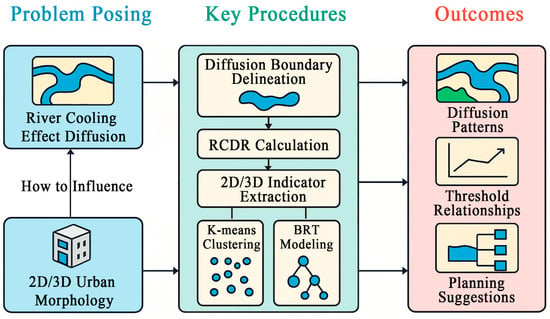
Figure 1.
Analytical framework of the impact of urban morphology on river cooling effect diffusion.
2.2. Study Area
This study focuses on the riverside area of the Huangpu River within Central Shanghai (inside the Outer Ring Road) as the research area (Figure 2). Shanghai, located on China’s eastern coast, is an international metropolis and the nation’s economic center, but it faces a significant urban heat island threat [38]. As one of China’s megacities, Shanghai’s urbanization rate is 89.30%, with a population of 24.89 million by the end of 2020, making it one of the fastest-growing economic regions [39]. Shanghai has a humid subtropical climate, characterized by hot and prolonged summers [40]. By the end of 2020, around 81% of Shanghai’s population was exposed to the heat island effect [38]. Improving the urban thermal environment is crucial for developing an international metropolis and beautiful Shanghai. Shanghai is also a typical water town, with 47,086 watercourses totaling 30,389.4 km, and water bodies covering 10.4% of the city’s area (649.2 km2) [41]. This has led to the creation of a unique linear cooling corridor system, which plays a key role in mitigating the urban heat island effect.
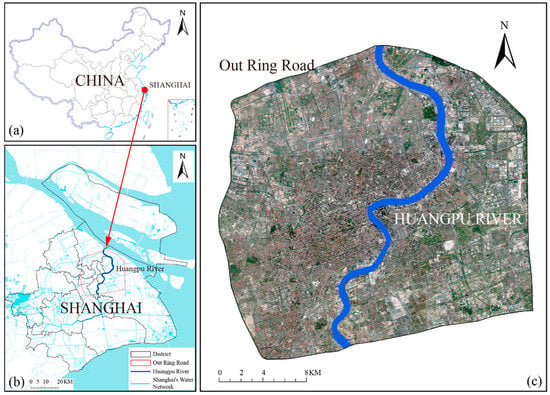
Figure 2.
Study area. (a) Location of Shanghai within China; (b) location of the study area within Shanghai and the distribution of Shanghai’s water network; (c) location of the Huangpu River within the central urban area.
The Huangpu River is Shanghai’s most important river and a vital component of the city’s blue-green space cooling network [42]. Spanning 113 km in length, the river varies in width from 300 m to 770 m, with the city center section extending 39 km [13]. The Huangpu River’s banks are densely populated, economically significant, and culturally rich, hosting numerous major economic activities [43,44]. This region has become a hub for economic and social development, as well as a focal point for urban planning and design. However, recent increases in building density, traffic flow, and the reduction in natural surfaces have made the Huangpu River’s waterside areas concentrated heat zones, creating an urgent need for cooling [6]. Enhancing the Huangpu River’s thermal regulation capacity and boosting cooling effect diffusion to riverside spaces and the urban interior is crucial.
2.3. Data Source and Preprocessing
In this study, three datasets were used, including Landsat 8 and GF-2 (a high-resolution Earth observation satellite developed by China) satellite imagery, and 3D building vector data from Baidu Maps (a widely used Chinese digital mapping platform). The data processing flow is shown in Figure 3. Given the impracticality of utilizing measured air temperature data for investigating river cooling effects at large scales, the land surface temperature (LST) has been extensively adopted in blue-green space cooling diffusion studies [13,25]. This preference arises from its accessibility, capacity to represent spatially extensive temperature patterns synchronously, and its strong positive correlation with air temperature under certain conditions [45]. Consequently, this study employs LST derived from Landsat 8 OLI/TIRS imagery from the Geospatial Data Cloud to characterize thermal variations, with a spatial resolution of 30 m. This study focuses on the typical cooling effect diffusion patterns of urban rivers and thus analyzes data from a hot summer day. Images from recent years were screened, and only the one captured on 16 August 2020, at 10:25 a.m. local time met the condition of cloud-free coverage over the study area. Additionally, to minimize the influence of wind on the diffusion process, wind data from a weather website “https://rp5.ru (accessed on 17 January 2024)” confirmed that the weather at the time was calm, which aligns with the requirements of this study. Radiation calibration and atmospheric correction were performed using ENVI 5.6, and land surface temperature was calculated with the radiative transfer equation [46].
where is the thermal infrared radiance received by the satellite sensor, and ε is the surface emissivity, which was estimated using the NDVI-based method [46]. and refer to the downwelling and upwelling atmospheric radiance, respectively, while τ is the atmospheric transmittance. The parameters , and τ were obtained using NASA’s Atmospheric Correction Parameter Calculator. represents the blackbody radiance emitted from the Earth’s surface at temperature . Finally, the land surface temperature () was calculated by inverting Planck’s law:
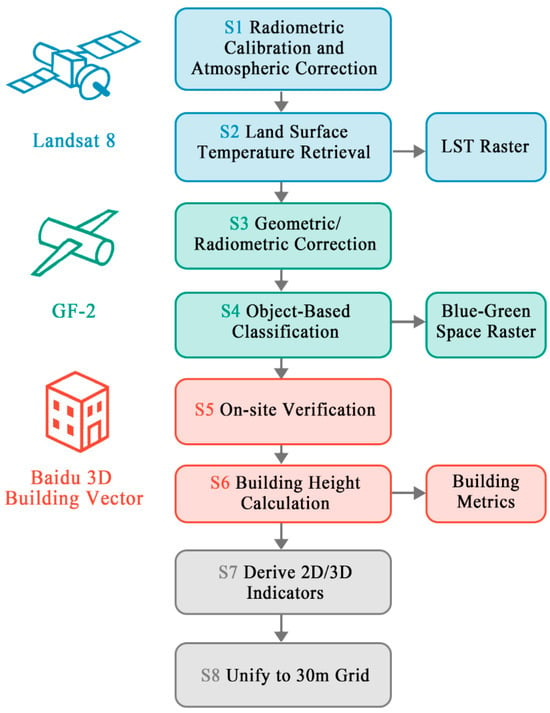
Figure 3.
Data preprocessing flowchart for LST retrieval, blue-green land-cover mapping, and 3D building metric extraction.
For Landsat 8 TIRS Band 10, the calibration constants are K1 = 774.89 W/(m2·μ·m·sr), K2 = 1321.08 K.
The GF-2 imagery, with a spatial resolution of 0.8 m for panchromatic and 3.2 m for multispectral imagery, was captured on 11 April 2022, and used for land cover classification in the study area. The GF-2 imagery underwent radiometric calibration, atmospheric correction, and orthorectification using ENVI 5.6 software [47]. After preprocessing both the panchromatic and multispectral images, the NNDiffusePan Sharpening algorithm in ENVI 5.6 was applied for image fusion. This composite image enabled better identification of the blue-green space distribution in the study area. Supervised classification tools were employed to interpret the distribution of trees, grasslands, and water bodies. In this step, trees, grassland, and water body patches were evenly selected as samples, and additional vegetation in shadowed regions, which are harder to identify, was supplemented through field research. The overall classification accuracy (P0) was 0.889, and the Kappa coefficient was 0.852, meeting the study’s requirements. Trees, grasslands, and water bodies were combined into a single category to represent the city’s blue-green space.
The 3D building vector data (https://map.baidu.com/) provides the number of floors for each building in 2019. This data is commonly used in building height studies for Chinese urban climate research [26,48]. We calibrated the building data, including location and height, using GF-2 remote sensing imagery, Baidu Street View images “http://quanjing.baidu.com/#/ (accessed on 23 October 2023)”, and field surveys. Building height was calculated by multiplying the number of floors by 3, following relevant studies and current standards [49,50].
2.4. Identification of River Cooling Effect Diffusion
2.4.1. Basin Method Used for Delineating Diffusion Boundaries
Accurately identifying the cooling effect diffusion range of rivers is crucial for assessing the river’s cooling effect diffusion capacity and its influencing factors. The cooling effect of a river diminishes and eventually disappears as the distance from the riverbank increases. The cooling effect diffusion range of a river segment is represented by the point on the curve where the temperature undergoes a sudden change or levels off for the first time [18,19]. River cooling diffusion results from complex thermal–spatial interactions. To isolate the river’s cooling effect, we must exclude interference from adjacent thermal sources while analyzing urban spatial impacts within the cooling zone. Building on previous work [13,19], this study applies a basin delineation method that identifies cooling boundaries through remote sensing. By connecting temperature inflection points, this approach defines a distinct area where cooling effects originate exclusively from the river. This method uses the “Flow Direction” tool in ArcGIS 10.8 to calculate the surface temperature flow direction. Next, the “Watershed” tool was used to calculate the river’s cooling range. The contour representing the boundary of the river’s cooling effect was then obtained.
2.4.2. Indicators to Control the Influences of Landscape Contexts
To study the relationship between 2D/3D urban morphology and river’s cooling effect diffusion, this study required dividing both sides of the Huangpu River into statistical units. Within the river’s independent cooling range, it is assumed that the area is solely influenced by the river’s cooling effect diffusion [13]. Thus, the river cooling range identified using the basin method serves as the outer boundary for the research units. Since the river’s cooling effect diffusion direction is perpendicular to the riverbank, statistical units need to be divided along this direction. In studies of complex urban environments, the sample scale significantly impacts the results. The division of river segments should avoid the mutual influence of cooling effect diffusion between adjacent segments [51]. Given that the spatial resolution of LST is 30 m, and in line with existing research [20,52], a 300m interval was chosen for dividing the river segments. After excluding segments with sharp bends and those where the riverbank temperature is significantly affected by nearby infrastructure, a total of 249 units were identified (Figure 4).
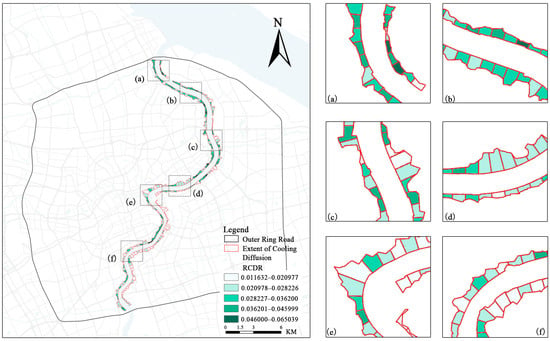
Figure 4.
Spatial distribution of cooling effect diffusion resistance and cooling effect diffusion distance of the Huangpu River. (a–f) Magnified views of the nodes for typical river sections.
2.4.3. Calculation of Diffusion Resistance in River Cooling
The river cooling diffusion capacity can be quantified by the temperature recovery rate within the cooling zone. Faster temperature recovery indicates increased resistance during cooling diffusion processes. The rate of temperature change is directly correlated with the isotherm spacing density. Isotherms effectively capture spatial temperature variations, and their configuration—particularly movement patterns and spatial density—reflects underlying temperature gradient dynamics, which are essential for analyzing cooling diffusion mechanisms [53]. A higher density of isotherms indicates a steeper temperature gradient, signifying greater thermal variation intensity and stronger resistance to cooling diffusion (see Appendix A). To systematically characterize the river cooling effect diffusion capacity, this study developed the river cooling effect diffusion resistance (RCDR) index. The RCDR quantifies spatial temperature change rates by calculating isotherm line density within defined river segments. The calculation formula is as follows:
where RCDR is the river cooling effect diffusion resistance, is the total length of the 1 °C isotherms within the statistical unit, and refers to the total area of the statistical unit—defined as the spatial unit used to analyze river cooling effect diffusion. This formula is designed to capture the cooling effect diffusion resistance by reflecting the rate of temperature change within the cooling zone.
2.5. Construction of 2D/3D Urban Morphology Indicators
Based on studies of urban morphological characteristics [20,25,34] and intending to directly inform riverside space planning and design, this study selected seven 2D/3D urban morphological indicators. Table 1 presents the definitions, descriptions, and calculation formulas of the seven indicators. The statistical region refers to the area within the cooling effect diffusion range. This research uses blue-green space to represent 2D landscape features. BGR, LSI, and AI quantify the quantity [26], shape complexity [54], and spatial aggregation characteristics of blue-green space [55], respectively. BD, BH, BMD, and BRFI quantify the 3D building morphology around the river. These indicators provide a comprehensive description of the urban energy balance process. BD and BH represent the quantity and configuration of buildings, which influence anthropogenic heat flux [25]. This study also introduces two new indicators, BMD and BRFI, to represent building layout features. BMD characterizes the angular relationship between buildings and the riverbank and explores how building orientation influences river cooling effect diffusion [18]. BRFI, modeled after the frontal area index (FAI), represents the obstruction caused by buildings in the direction of river cooling effect diffusion [6,56]. The 2D landscape morphology indicators were obtained using Fragstats 4.2, while the 3D building morphology indicators were calculated using ArcGIS 10.8 and R 4.3.2. This study used Spearman’s correlation coefficient and the Variance Inflation Factor (VIF) to test factor collinearity and exclude highly collinear factors.

Table 1.
Detailed information on the 2D/3D urban morphology factors selected in this study.
2.6. K-Means Clustering of Urban Morphology
This study employed K-means clustering to identify typical urban morphology types [57]. K-means was selected for its simplicity, effectiveness in grouping data by feature similarity, and its common use in clustering analysis [58]. The algorithm assigns each sample to the nearest centroid, minimizing intra-cluster differences. This method is widely used in urban morphology classification [57]. This study classifies the riverside space based on seven urban morphological indicators. Prior to clustering, the data underwent standardization, missing value handling, and outlier removal. After preprocessing, 249 river segment samples were clustered using the K-means algorithm in R 4.3.2. To determine the optimal number of clusters, this study applied the Elbow method, which uses the Within-Cluster Sum of Squares (WSS) as the representative metric [59]. Specifically, the WSS changes were observed across different values of K using the Elbow plot, with the “elbow” position selected as the optimal K value, which was determined to be 3. This method effectively avoids the issues of over-clustering or under-clustering, ensuring the stability of the clustering results. The NbClust and factoextra packages in R 4.3.2 were used to implement these steps. After clustering, the median urban morphology features for each cluster were calculated to better understand the typical morphology in the study area.
2.7. Analysis of Relative Contributions and Marginal Effects Using BRT Model
Given the difficulty of capturing complex nonlinear relationships in cooling effects with simple statistical analysis, this study used the Boosting Regression Tree (BRT) model. The BRT model combines regression trees and boosting models, allowing for the analysis of nonlinear relationships between variables. It also enables a comprehensive analysis of each variable’s role through relative contribution and marginal effect curves [51,60]. The relative contribution measures each independent variable’s influence on the dependent variable, while the marginal effect curve quantifies its influence relationship and threshold. The BRT model is widely used in urban planning and heat island mitigation research [61]. This model was constructed using the processes, code, and parameters from Elith et al., supported by the gbm package in R 4.3.2 [62,63]. The model uses 2D/3D urban morphology indicators as independent variables and river cooling effect diffusion resistance as the dependent variable to investigate the influence of urban spatial factors on cooling effect diffusion. To mitigate overfitting risks from limited sample sizes, parameter optimization was systematically implemented to ensure robust results. The model parameters are as follows: tree complexity = 3, learning rate = 0.01, bag fraction = 0.5, data type = Gaussian distribution, and 10-fold cross-validation [25,31,64].
3. Results
3.1. Cooling Effect Diffusion Characteristics of the Huangpu River
Figure 4 presents the cooling effect diffusion range calculation results for the Huangpu River. The cooling effect diffusion boundary (red line) of the Huangpu River is spatially irregular, indicating non-uniform diffusion. The results show that the maximum cooling effect diffusion distance for each Huangpu River segment is 817.68 m, the minimum is 50.4 m, and the average is 192.72 m. The river cooling effect diffusion resistance ranges from 0.012 to 0.065, with an average of 0.029, showing significant variation across river segments. A scatter plot of the cooling effect diffusion distance and resistance across Huangpu River segments shows that 89% have diffusion distances under 300 m. A total of 72% of segments have a cooling effect diffusion resistance between 0.02 and 0.04. Figure 5 illustrates the relationship between the cooling effect diffusion distance and resistance for the Huangpu River. The results suggest no significant correlation between the two, meaning that a larger diffusion distance does not necessarily indicate easier diffusion. The reasons for this will be discussed in the Discussion section.
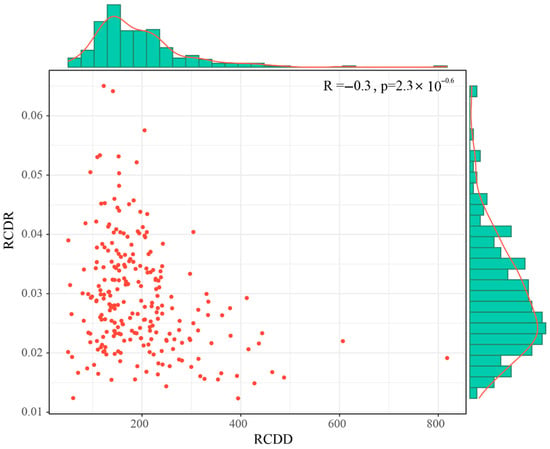
Figure 5.
Scatter plot of cooling effect diffusion distance and cooling effect diffusion resistance of the Huangpu River.
3.2. Urban Morphological Characteristics Along the Huangpu River
The urban morphology along the Huangpu River is provided in Figure 6. It illustrates the spatial distribution of urban morphology types in the study area. Over years of development, the Huangpu River waterside has become diverse in functional types. To describe the urban morphological characteristics of the riverside area, this study used the K-means algorithm to classify river sections based on seven morphology indicators. The clustering results reveal that the Huangpu River waterside consists of three typical spatial types. Cluster 1, with 127 samples, is mainly distributed along the southern river section, with some scattering in the northern and central sections. Cluster 2, with 24 samples, is mainly found along the central section of the Huangpu River. Cluster 3, with 98 samples, is primarily found along the northern Huangpu River section (Figure 7).
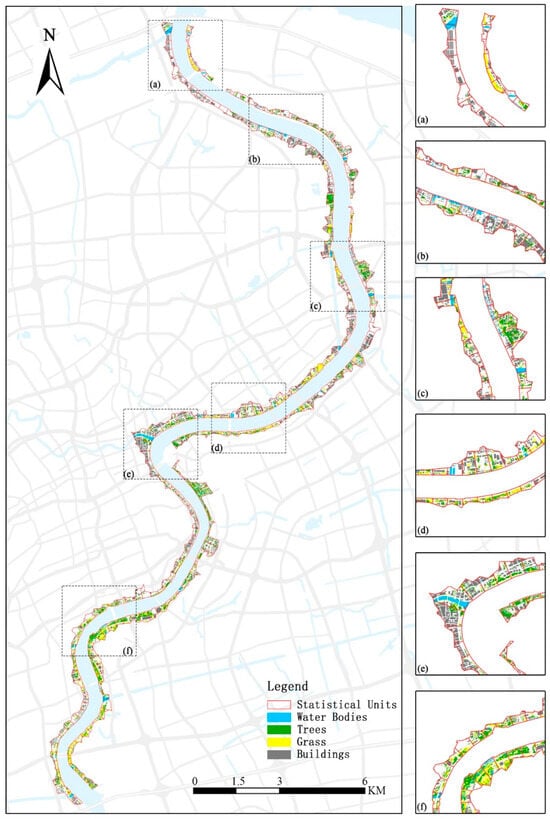
Figure 6.
Urban morphology elements of the Huangpu River waterside area. (a–f) Enlarged maps of key nodes in typical river sections.
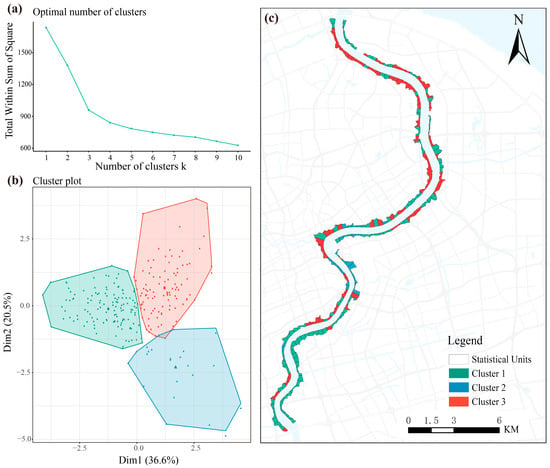
Figure 7.
Clustering results of urban morphology along the Huangpu River: (a) the number of clusters determined using the Elbow method; (b) results of the clustering analysis using K-means; (c) spatial distribution of different typical river segment types.
Figure 8 presents the statistical characteristics of urban morphology for different riverside sections along the Huangpu River. Cluster 1 corresponds to parks, riverside green areas, and well-landscaped residential neighborhoods, characterized by a high proportion of blue-green space, low building density, and low building height. Cluster 2 corresponds to commercial and business districts, with the highest average building height and moderate levels of blue-green space and building density. Cluster 3 corresponds to high-density urban blocks, industrial areas, and docks, characterized by low blue-green space, high building density, and moderate building height. In terms of BRFI, Cluster 2 has the highest, with significant variation; Cluster 3 ranks second, and Cluster 1 has the lowest. Regarding AI, Cluster 1 has the highest, followed by Cluster 2, while Cluster 3 has the lowest, with significant variation. Furthermore, in terms of BMD and the LSI, the differences across river segments are considerable, with no significant characteristics observed within each cluster. The spatial distribution of 2D/3D urban morphology indicators along the Huangpu River is detailed in Figure 9.
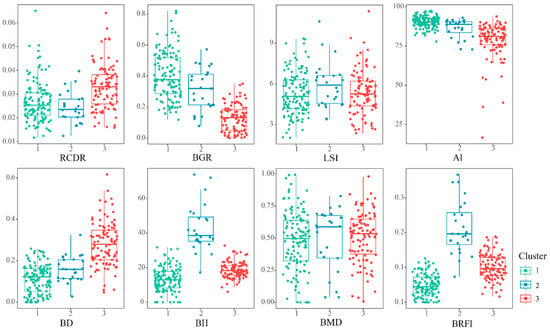
Figure 8.
Box plot of urban morphological characteristics for different types of segments of the Huangpu River.
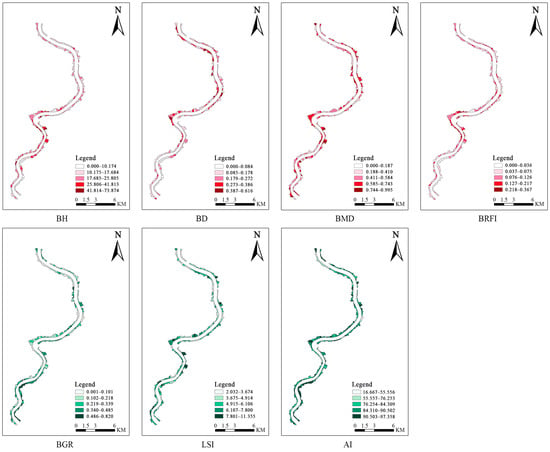
Figure 9.
Spatial distribution of 3D architectural spatial morphological features and 2D landscape spatial morphological features.
3.3. Correlation of Indicators and Reliability of the Model
Spearman correlation analysis was used to test the relationships between variables, with the results shown in Figure 10. The results show that, except for BH and BMD, all other variables are significantly correlated with the dependent variable RCDR. The highest correlation is between BGR and RCDR, followed by the LSI. This suggests that areas with more blue-green space may facilitate river cooling effect diffusion. Generally, open areas with more blue-green space tend to favor river cooling effect diffusion, but the nonlinear relationship requires further exploration. After conducting the Spearman correlation analysis and testing collinearity with VIF, the results showed that all independent variable VIF values were below 5, confirming their suitability for subsequent analysis [31,65].
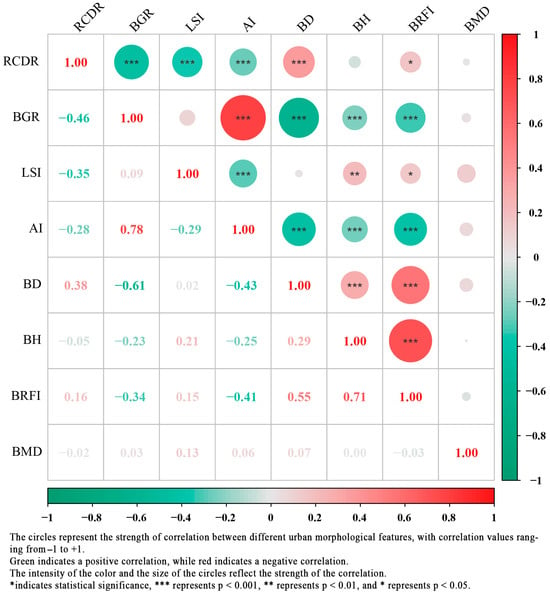
Figure 10.
Spearman correlation matrix of 2D/3D urban morphological indicators and river cooling effect diffusion resistance.
The BRT model in this study used 400 decision trees for fitting. The total mean squared deviation was 87.12, reflecting the overall deviation between the model’s predictions and actual values. The average residual deviation was 37.682. The cross-validation (CV) estimated deviation was 61.203, with a standard error of 9.106, indicating stable and reliable estimates. The training data correlation coefficient was 0.769, indicating a strong positive linear relationship between the model’s predictions and actual values. The cross-validation correlation coefficient was 0.555, with a standard error of 0.047. This indicates a strong correlation between the model’s predictions and actual values during cross-validation. These results demonstrate that the model meets the required prediction accuracy.
3.4. The Impact of Urban Morphology Factors on Cooling Effect Diffusion Along the Huangpu River
3.4.1. Relative Contribution of Urban Morphology Factors
Figure 11 shows the relative importance of four 3D building factors and three 2D landscape factors in river cooling effect diffusion intensity, as determined using the BRT method. The total contribution of 3D building morphology factors is 45.2%, while 2D landscape morphology factors contribute 54.8%, indicating that 2D factors have a greater impact on river cooling. Specifically, the LSI contributes the most (26%), followed by BGR at 21.4%, BD at 18%, and BH at 10.7%. The contributions of BRFI, BMD, and AI are all under 10%.
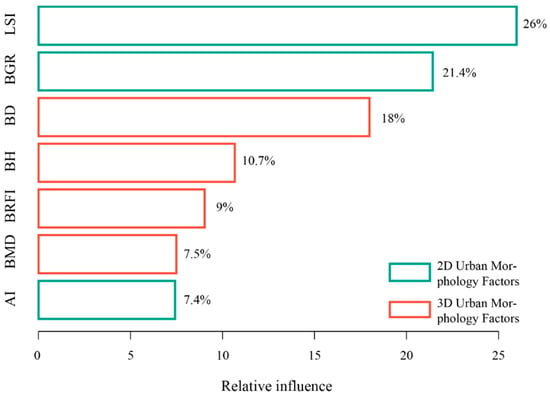
Figure 11.
Relative contribution of 2D/3D urban morphology factors to cooling effect diffusion of the Huangpu River.
3.4.2. Marginal Effects of Urban Morphology Factors
Figure 12 shows the marginal effect curves of river cooling effect diffusion resistance in the BRT model, ranked by their relative contributions. The marginal effect curves show how changes in a variable affect river cooling effect diffusion, with other variables held at their average values [66]. The impact of diffusion intensities on the thermal environment varies in both trend and strength. Factors promoting cooling effect diffusion include the LSI, BH, and AI, with the LSI having the strongest effect, followed by BH. BD and BRFI inhibit diffusion. The marginal effect curve of BGR rises initially and then falls. While the marginal effect curve of BMD fluctuates, its overall trend is unclear.
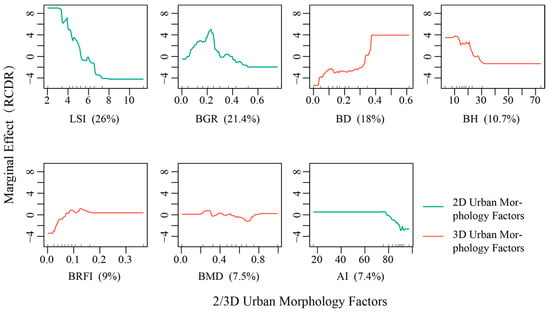
Figure 12.
Marginal effect curve of the 2D/3D urban morphology factors on the cooling effect diffusion of the Huangpu River.
BGR, LSI, and AI together describe the 2D landscape morphology of the riverside area. BGR represents the amount of blue-green space on the site. The marginal effect curve shows that as BGR increases, diffusion resistance initially rises and then falls, with an inflection point around 0.2. This suggests that a larger proportion of blue-green space does not always lead to better diffusion. Cooling effect diffusion is only promoted when the blue-green space exceeds 20%. The LSI represents the complexity of the shape of blue-green spaces. The marginal effect curve shows that as the complexity of blue-green space shapes increases, diffusion resistance decreases. AI represents the degree of aggregation of blue-green space. The marginal effect curve shows that when AI exceeds 80, diffusion resistance gradually decreases.
Among the 3D urban morphology factors, BD represents building density. As building density increases, resistance to river cooling effect diffusion also rises, intensifying temperature changes. However, when BD reaches 0.4, diffusion resistance peaks. Notably, when BD is between 0.15 and 0.3, the change in river cooling effect diffusion resistance is minimal. Once BD exceeds 0.3, diffusion resistance increases sharply. BH represents the average building height. The results show that higher buildings facilitate cooling effect diffusion, with a threshold around 30 m. BRFI represents the projected area of buildings along the riverbank, indicating the permeability of the plot in the river-facing direction. The results show that a larger BRFI, or more permeable plots in the river-facing direction, leads to lower resistance to cooling effect diffusion. BMD represents the absolute value of the sine of the angle between buildings and the riverbank. A larger BMD value indicates a more perpendicular alignment of buildings to the riverbank, but the marginal effect results do not reveal a clear pattern.
4. Discussion
4.1. Unevenness and Typical Patterns of River Cooling Effect Diffusion
The cooling effect diffusion resistance index provides a crucial metric for analyzing river cooling processes. Previous studies typically used the cooling distance as the primary measure of diffusion characteristics, but it fails to fully capture diffusion dynamics. Figure 5 shows the relationship between the river cooling effect diffusion distance (RCDD) and river cooling effect diffusion resistance (RCDR). This shows that there is no clear correlation between diffusion distance and resistance. A greater diffusion distance does not necessarily indicate lower resistance or easier diffusion, due to the complex relationship between these factors. This study assumes consistent cooling intensity from the river’s cooling source and identifies four diffusion modes based on the relationship between diffusion distance and resistance (Figure 13). (1) Large RCDD-Small RCDR: This is the most ideal mode, with low diffusion resistance, moderate temperature change, and a long diffusion distance. (2) Small RCDD-Large RCDR: This is the least ideal mode, with both high resistance and a short diffusion distance. (3) Small RCDD-Small RCDR: In this mode, diffusion resistance is low, but the distance remains short. This occurs due to a nearby strong cooling source interacting with the river’s cooling source. Both sources create their own cooling zones, limiting the river’s cooling effect diffusion range [13]. In other words, surrounding strong cooling sources suppress the river’s cooling distance. This further explains how urban spatial heterogeneity causes non-uniform river cooling effect diffusion. (4) Large RCDD-Large RCDR: In this mode, although the diffusion distance is long, the diffusion resistance is high. This occurs due to a strong heat source at the diffusion boundary. The heat source’s high temperature delays the inflection point of the cooling curve, resulting in a longer cooling distance. Adjacent thermal and cold sources significantly influence river cooling distances. The results show that longer cooling distances do not necessarily correlate with better diffusion efficacy. This confirms the insufficiency of cooling distance metrics alone in describing diffusion effectiveness. Therefore, this study proposes a cooling effect diffusion resistance index specifically for isolated river cooling zones. This index enables accurate evaluation of river cooling diffusion effects.
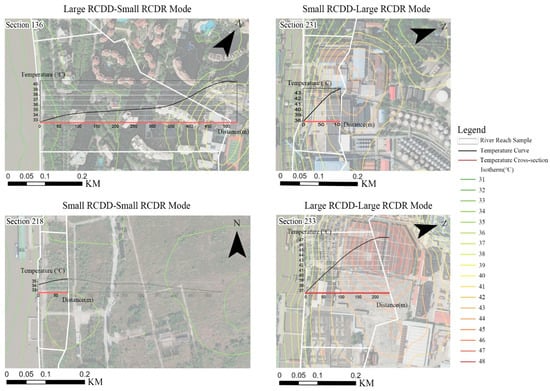
Figure 13.
Four patterns of river cooling effect diffusion.
4.2. Impact of Complex Urban Morphological Characteristics on River Cooling Effect Diffusion Resistance
The seven 2D/3D urban morphological indicators within the river’s isolated cooling range jointly influence river cooling effect diffusion, each with varying impacts. The marginal effect curves for 3D building morphology show that as BD increases, diffusion resistance also increases. When BD reaches 0.3, RCDR significantly increases. This turning point may be due to the fact that at lower BD (e.g., <0.3), urban areas have better ventilation, allowing air to flow effectively. However, once BD exceeds this threshold, the concentration of buildings restricts airflow, leading to a decline in the cooling effect [67]. A similar conclusion was drawn by Zhou et al. (2024), who studied the impact of riparian building morphology on urban microclimate using ENVI-met simulations [29]. As BH increases, diffusion resistance decreases. This could be because taller buildings may create a “venturi effect,” forming wind corridors that bring cool, moist air from the river to inland areas [68]. Regarding building orientation and arrangement, higher BRFI increases diffusion resistance. This likely occurs because higher BRFI results in greater obstruction to cooling effect diffusion, hindering the flow of cool air from the river inland. We assume that the more perpendicular a building’s dominant orientation to the riverbank, the higher the permeability, and the lower the diffusion resistance. Interestingly, the marginal effect curve for building orientation within the land parcel showed no clear pattern, which is counterintuitive. This may be due to the complex and diverse building morphology in the Huangpu riverside area, with scattered factory layouts, point-type high-rise buildings in residential areas, and varied public function buildings, leading to atypical computed dominant orientations.
The marginal effect curves for 2D landscape morphology show that the LSI has the highest contribution, with diffusion resistance decreasing as the LSI increases. This is likely because a higher LSI indicates more complex blue-green space shapes, which promote river cooling effect diffusion. In river segments with a higher LSI, the blue-green space area is larger, and the connectivity between spaces is greater. Thus, the blue-green space morphology indicated by a higher LSI favors river cooling effect diffusion and is the most significant factor. Similar conclusions have been found in previous studies [25]. Numerous studies highlight the LSI’s important role in cooling [69,70]. As BGR increases, diffusion resistance rises before decreasing, with a turning point around 0.2. This is likely because blue-green spaces, as secondary cooling sources in summer, need to reach a certain scale to effectively collaborate with river cooling. Blue-green spaces create a cooler temperature field, which can help reduce diffusion resistance. However, insufficient blue-green space fails to contribute to diffusion and may hinder it. When AI exceeds 80, diffusion resistance gradually decreases, indicating that aggregating blue-green spaces benefits cooling effect diffusion.
4.3. Insights on Riverside Spatial Planning and Design from the Perspective of Cooling Effect Diffusion
Optimizing urban morphology in riverside areas to maximize cooling effect diffusion and benefit inland areas from river-cooled air is a novel approach for planning and design. First, it is essential to clarify the goals of river cooling. Since LST, RCD, and RCDR have distinct definitions and mechanisms, planning should balance between lower LST, longer RCD, and smaller RCDR while defining cooling objectives. For instance, large blue-green spaces around rivers may have lower LST, but they may not benefit from cooling effect diffusion as effectively [13]. Next, urban morphology planning for riverside areas must consider the characteristics of different river segments. Cluster 1 includes parks, riverside green spaces, and well-landscaped residential areas, which have a strong diffusion potential. While preserving existing blue-green coverage, it is essential to control building numbers and maintain the complexity and connectivity of blue-green spaces to boost diffusion potential. Cluster 2 includes business and commercial districts, which are the most densely populated and functionally diverse river segments. Therefore, building density should be controlled, with special focus on increasing and concentrating complex-shaped blue-green spaces. Cluster 3 includes high-density areas like industrial districts and docks, which are among the most common features along the Huangpu River. These segments have poor cooling effect diffusion and need optimization. We recommend increasing blue-green spaces, even if scattered, but ensuring their total area exceeds 20%. Insufficient blue-green space hinders cooling effect diffusion. Maintaining the complex shape of blue-green spaces is also important. In redeveloping industrial dock areas, building density should be controlled within 0.3 to enhance the diffusion capacity.
4.4. Limitations
This study investigates the characteristics of efficient cooling effect diffusion in complex urban environments by analyzing the relationship between 2D/3D urban morphology and river-induced cooling diffusion resistance. However, due to regional variations in climatic conditions—such as temperature, humidity, and wind speed—the intensity and spatial pattern of cooling effects may differ. As a result, the findings of this study may not be directly generalized to riparian areas in cities with different geographic and morphological contexts. Validation using a larger sample of cities is needed to test the broader applicability of the results. Nonetheless, the technical framework developed in this study is highly transferable, as it relies on readily available and easily processable data, making it adaptable to diverse urban settings. Due to frequent summer rainfall in Shanghai, acquiring cloud-free satellite images across different seasons and times proved challenging. To mitigate these limitations, we verified image quality using historical meteorological records, and histograms of surface temperature data indicated no irregularities. Moreover, previous studies utilizing the same dataset have produced consistent and reliable results [51,71], further supporting the validity of our data.
5. Conclusions
This study constructs a framework to explore how 2D/3D urban morphology influences river cooling effect diffusion in riverside areas, utilizing a BRT model to fit the nonlinear relationship between urban morphology indicators and cooling effect diffusion resistance. An empirical analysis was conducted on the central urban section of the Huangpu River in Shanghai to identify key urban morphology features with high diffusion potential. The main findings are as follows: (1) Cooling diffusion characteristics vary across river sections, with an average diffusion distance of 192.75m and resistance of 0.029. (2) The relative contributions of 2D/3D urban morphology indicators to cooling diffusion differ, with the LSI contributing most (26%) and BGR second (21.4%). (3) Marginal effect curves show that areas with a higher proportion, more complex blue-green spaces, and lower building density have stronger cooling diffusion. The best diffusion occurs when the blue-green space proportion exceeds 0.2 and building density is between 0.1 and 0.3.
Based on the thresholds quantified in this study, practical recommendations are proposed for optimizing spatial morphology in riparian areas to maximize river cooling effect diffusion. For spatial morphology, it is recommended to control building density between 0.10 and 0.30, increase building height above 30 m, and arrange buildings perpendicular to the riverbank to create wind corridors, ensuring river-facing transparency. For blue-green infrastructure, the BGR should be no less than 20%, with improvements in green space complexity and aggregation. Specific management measures are also proposed for different clustering regions (Cluster 1–3). These threshold-driven strategies can be integrated into local riparian zoning regulations and blue-green infrastructure planning, offering a replicable blueprint for other megacities’ riverfronts.
Author Contributions
Conceptualization, Y.W. (Yuhui Wang) and Y.W. (Yuncai Wang); methodology, Y.W. (Yuhui Wang), J.H. and Y.W. (Yuncai Wang); software, Y.W. (Yuhui Wang); validation, Y.W. (Yuhui Wang), S.S., J.H. and Y.W. (Yuncai Wang); formal analysis, Y.W. (Yuhui Wang); investigation, Y.W. (Yuhui Wang); resources, Y.W. (Yuhui Wang); data curation, Y.W. (Yuhui Wang); writing—original draft preparation, Y.W. (Yuhui Wang); writing—review and editing, Y.W. (Yuhui Wang), S.S., J.H. and Y.W. (Yuncai Wang); visualization, Y.W. (Yuhui Wang); supervision, Y.W. (Yuncai Wang); project administration, Y.W. (Yuncai Wang); funding acquisition, Y.W. (Yuncai Wang). All authors have read and agreed to the published version of the manuscript.
Funding
This work was supported by the National Natural Science Foundation of China (grant No. 52238003).
Data Availability Statement
The original contributions presented in the study are included in the article; further inquiries can be directed to the corresponding author.
Conflicts of Interest
The authors declare no conflicts of interest.
Appendix A
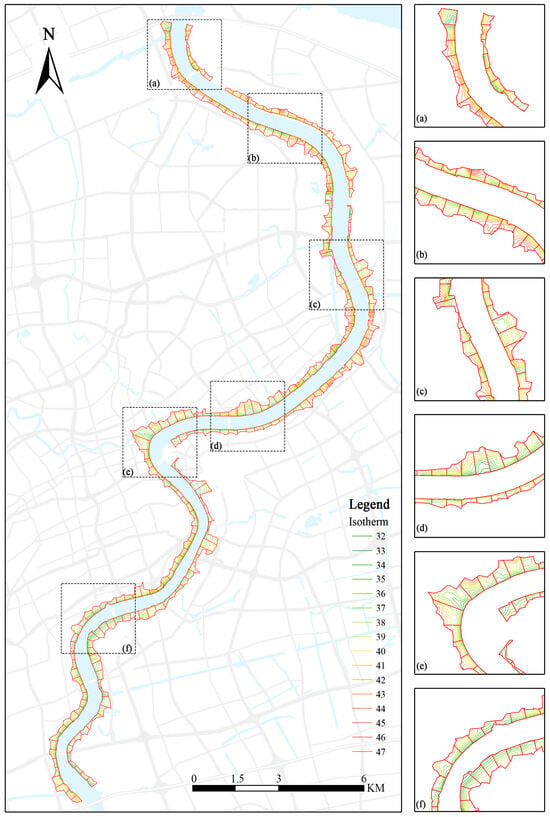
Figure A1.
Isothermal map of the study area. (a–f) Enlarged maps of key nodes in typical river sections.
References
- IPCC. AR6 Synthesis Report: Climate Change 2023—IPCC 2023. Available online: https://www.ipcc.ch/report/ar6/syr/ (accessed on 25 November 2024).
- Thompson, V.; Mitchell, D.; Hegerl, G.C.; Collins, M.; Leach, N.J.; Slingo, J.M. The Most At-Risk Regions in the World for High-Impact Heatwaves. Nat. Commun. 2023, 14, 2152. [Google Scholar] [CrossRef] [PubMed]
- Martins, T.A.L.; Adolphe, L.; Bonhomme, M.; Bonneaud, F.; Faraut, S.; Ginestet, S.; Michel, C.; Guyard, W. Impact of Urban Cool Island Measures on Outdoor Climate and Pedestrian Comfort: Simulations for a New District of Toulouse, France. Sustain. Cities Soc. 2016, 26, 9–26. [Google Scholar] [CrossRef]
- Verma, A.; Agrawal, S. Evaluating the Natural Cooling Potential of Waterbodies in Dense Urban Landscape: A Case Study of Bengaluru, India. Urban Clim. 2024, 58, 102200. [Google Scholar] [CrossRef]
- Cai, Z.; Guldmann, J.-M.; Tang, Y.; Han, G. Does City-Water Layout Matter? Comparing the Cooling Effects of Water Bodies across 34 Chinese Megacities. J. Environ. Manag. 2022, 324, 116263. [Google Scholar] [CrossRef] [PubMed]
- Jiang, L.; Liu, S.; Liu, L.; Liu, C. Revealing the Spatiotemporal Characteristics and Drivers of the Block-Scale Thermal Environment near a Large River: Evidences from Shanghai, China. Build. Environ. 2022, 226, 109728. [Google Scholar] [CrossRef]
- Zhou, W.; Wu, T.; Tao, X. Exploring the Spatial and Seasonal Heterogeneity of Cooling Effect of an Urban River on a Landscape Scale. Sci. Rep. 2024, 14, 8327. [Google Scholar] [CrossRef] [PubMed]
- Fricke, L.; Legg, R.; Kabisch, N. Impact of Blue Spaces on the Urban Microclimate in Different Climate Zones, Daytimes and Seasons—A Systematic Review. Urban For. Urban Green. 2024, 101, 128528. [Google Scholar] [CrossRef]
- Zhang, L.; Meng, Q.; Yao, S.; Qian, J.; Gao, J.; Wu, J. How to Optimize Urban Blue Space to Maximize Its Cooling Benefits? A Case Study in Megacity of Beijing. Build. Environ. 2025, 270, 112502. [Google Scholar] [CrossRef]
- Manteghi, G.; Limit, H.B.; Remaz, D. Water Bodies an Urban Microclimate: A Review. Mod. Appl. Sci. 2015, 9, 1–12. [Google Scholar] [CrossRef]
- Völker, S.; Baumeister, H.; Claßen, T.; Hornberg, C.; Kistemann, T. Evidence for the Temperature-Mitigating Capacity of Urban Blue Space—A Health Geographic Perspective. Erdkunde 2013, 67, 355–371. [Google Scholar] [CrossRef]
- Jandaghian, Z.; Colombo, A. The Role of Water Bodies in Climate Regulation: Insights from Recent Studies on Urban Heat Island Mitigation. Buildings 2024, 14, 2945. [Google Scholar] [CrossRef]
- Jiang, L.; Liu, S.; Liu, C.; Feng, Y. How Do Urban Spatial Patterns Influence the River Cooling Effect? A Case Study of the Huangpu Riverfront in Shanghai, China. Sustain. Cities Soc. 2021, 69, 102835. [Google Scholar] [CrossRef]
- Feng, X.; Li, M.; Zhou, Z.; Li, F.; Wang, Y. Quantifying the Cooling Effect of River and Its Surrounding Land Use on Local Land Surface Temperature: A Case Study of Bahe River in Xi’an, China. Egypt. J. Remote Sens. Space Sci. 2023, 26, 975–988. [Google Scholar] [CrossRef]
- Du, C.; Jia, W.; Chen, M.; Yan, L.; Wang, K. How Can Urban Parks Be Planned to Maximize Cooling Effect in Hot Extremes? Linking Maximum and Accumulative Perspectives. J. Environ. Manag. 2022, 317, 115346. [Google Scholar] [CrossRef] [PubMed]
- Guo, A.; Yue, W.; Yang, J.; Li, M.; Zhang, Z.; Xie, P.; Zhang, M.; Lu, Y.; He, T. Quantifying the Cooling Effect and Benefits of Urban Parks: A Case Study of Hangzhou, China. Sustain. Cities Soc. 2024, 113, 105706. [Google Scholar] [CrossRef]
- Lai, D.; Liu, W.; Gan, T.; Liu, K.; Chen, Q. A Review of Mitigating Strategies to Improve the Thermal Environment and Thermal Comfort in Urban Outdoor Spaces. Sci. Total Environ. 2019, 661, 337–353. [Google Scholar] [CrossRef] [PubMed]
- Park, C.Y.; Lee, D.K.; Asawa, T.; Murakami, A.; Kim, H.G.; Lee, M.K.; Lee, H.S. Influence of Urban Form on the Cooling Effect of a Small Urban River. Landsc. Urban Plan. 2019, 183, 26–35. [Google Scholar] [CrossRef]
- Lin, W.; Yu, T.; Chang, X.; Wu, W.; Zhang, Y. Calculating Cooling Extents of Green Parks Using Remote Sensing: Method and Test. Landsc. Urban Plan. 2015, 134, 66–75. [Google Scholar] [CrossRef]
- Cai, Z.; Han, G.; Chen, M. Do Water Bodies Play an Important Role in the Relationship between Urban Form and Land Surface Temperature? Sustain. Cities Soc. 2018, 39, 487–498. [Google Scholar] [CrossRef]
- Guo, F.; Xu, S.; Zhao, J.; Zhang, H.; Liu, L.; Zhang, Z.; Yin, X. Study on the Mechanism of Urban Morphology on River Cooling Effect in Severe Cold Regions. Front. Public Health 2023, 11, 1170627. [Google Scholar] [CrossRef] [PubMed]
- Li, Y.; Zhao, L.; Zheng, H.; Yang, X. Using New York City’s Geographic Data in an Innovative Application of Generative Adversarial Networks (GANs) to Produce Cooling Comparisons of Urban Design. Land 2025, 14, 1393. [Google Scholar] [CrossRef]
- Bokaie, M.; Zarkesh, M.K.; Arasteh, P.D.; Hosseini, A. Assessment of Urban Heat Island Based on the Relationship between Land Surface Temperature and Land Use/ Land Cover in Tehran. Sustain. Cities Soc. 2016, 23, 94–104. [Google Scholar] [CrossRef]
- Middel, A.; Häb, K.; Brazel, A.J.; Martin, C.A.; Guhathakurta, S. Impact of Urban Form and Design on Mid-Afternoon Microclimate in Phoenix Local Climate Zones. Landsc. Urban Plan. 2014, 122, 16–28. [Google Scholar] [CrossRef]
- Han, D.; Xu, X.; Qiao, Z.; Wang, F.; Cai, H.; An, H.; Jia, K.; Liu, Y.; Sun, Z.; Wang, S.; et al. The Roles of Surrounding 2D/3D Landscapes in Park Cooling Effect: Analysis from Extreme Hot and Normal Weather Perspectives. Build. Environ. 2023, 231, 110053. [Google Scholar] [CrossRef]
- Yuan, B.; Zhou, L.; Hu, F.; Wei, C. Effects of 2D/3D Urban Morphology on Land Surface Temperature: Contribution, Response, and Interaction. Urban Clim. 2024, 53, 101791. [Google Scholar] [CrossRef]
- Yu, Z.; Yang, G.; Zuo, S.; Jørgensen, G.; Koga, M.; Vejre, H. Critical Review on the Cooling Effect of Urban Blue-Green Space: A Threshold-Size Perspective. Urban For. Urban Green. 2020, 49, 126630. [Google Scholar] [CrossRef]
- Jang, G.; Kim, S.; Lee, J.S. Planning Scenarios and Microclimatic Effects: The Case of High-Density Riverside Residential Districts in Seoul, South Korea. Build. Environ. 2022, 223, 109517. [Google Scholar] [CrossRef]
- Zhou, Y.; Lu, Y.; Zhou, X.; An, J.; Yan, D. Numerical Study on the Coupling Effect of River Attributes and Riverside Building Forms on the Urban Microclimate: A Case Study in Nanjing, China. Sustain. Cities Soc. 2024, 107, 105459. [Google Scholar] [CrossRef]
- Liu, Y.; Zhang, W.; Liu, W.; Tan, Z.; Hu, S.; Ao, Z.; Li, J.; Xing, H. Exploring the Seasonal Effects of Urban Morphology on Land Surface Temperature in Urban Functional Zones. Sustain. Cities Soc. 2024, 103, 105268. [Google Scholar] [CrossRef]
- Wu, T.; Wang, X.; Xuan, L.; Yan, Z.; Wang, C.; Du, C.; Su, Y.; Duan, J.; Yu, K. How to Plan Urban Parks and the Surrounding Buildings to Maximize the Cooling Effect: A Case Study in Xi’an, China. Land 2023, 13, 1117. [Google Scholar] [CrossRef]
- Li, Z.; Wang, Z.; Wen, D.; Wu, L. How Urban Parks and Their Surrounding Buildings Affect Seasonal Land Surface Temperature: A Case Study in Beijing, China. Urban For. Urban Green. 2023, 87, 128047. [Google Scholar] [CrossRef]
- Qiu, K.; Jia, B. The Roles of Landscape Both inside the Park and the Surroundings in Park Cooling Effect. Sustain. Cities Soc. 2020, 52, 101864. [Google Scholar] [CrossRef]
- Zhou, T.; Jia, W.; Yan, L.; Hong, B.; Wang, K. Urban Park’s Vertical Canopy Structure and Its Varied Cooling Effect under Continuous Warming Climate. Urban Clim. 2024, 53, 101819. [Google Scholar] [CrossRef]
- Han, D.; An, H.; Cai, H.; Wang, F.; Xu, X.; Qiao, Z.; Jia, K.; Sun, Z.; An, Y. How Do 2D/3D Urban Landscapes Impact Diurnal Land Surface Temperature: Insights from Block Scale and Machine Learning Algorithms. Sustain. Cities Soc. 2023, 99, 104933. [Google Scholar] [CrossRef]
- Bernard, J.; Rodler, A.; Morille, B.; Zhang, X. How to Design a Park and Its Surrounding Urban Morphology to Optimize the Spreading of Cool Air? Climate 2018, 6, 10. [Google Scholar] [CrossRef]
- Tan, J.; Kuang, W.; Yu, D.; Zhou, W.; Li, X.; Liu, Q.; He, L. Investigating the Cooling Effects of Land Cover and Landscape Patterns Surrounding Rivers: Insights from the Subtropical City of Changsha, China. Urban Clim. 2024, 55, 101975. [Google Scholar] [CrossRef]
- Liu, D.; Zhou, R.; Ma, Q.; He, T.; Fang, X.; Xiao, L.; Hu, Y.; Li, J.; Shao, L.; Gao, J. Spatio-Temporal Patterns and Population Exposure Risks of Urban Heat Island in Megacity Shanghai, China. Sustain. Cities Soc. 2024, 108, 105500. [Google Scholar] [CrossRef]
- Shanghai Municipal Statistics Bureau. Resident Population and Urbanization Rate of Shanghai, 2010–2020. Available online: https://tjj.sh.gov.cn/ysqzzdgk/20220926/650792e3930346b193fb16077187acbd.html (accessed on 21 December 2024).
- Kottek, M.; Grieser, J.; Beck, C.; Rudolf, B.; Rubel, F. World Map of the Köppen-Geiger Climate Classification Updated. Meteorol. Z. 2006, 15, 259–263. [Google Scholar] [CrossRef] [PubMed]
- Shi, D.; Song, J.; Zhong, Q.; Myint, S.W.; Zeng, P.; Che, Y. Cooling Wisdom of ‘Water Towns’: How Urban River Networks Can Shape City Climate? Remote Sens. Environ. 2024, 300, 113925. [Google Scholar] [CrossRef]
- Shanghai Municipal Planning and Natural Resources Bureau. The Development and Construction Plan of the Huangpu River Coast (2018–2035). Available online: https://ghzyj.sh.gov.cn/ghjh/20200820/8068daedd94846b29e22208a131d52fc.html (accessed on 21 December 2024).
- Huang, J.; Wang, Y. Research on Social Service Effectiveness Evaluation for Urban Blue Spaces—A Case Study of the Huangpu River Core Section in Shanghai. Land 2023, 12, 1424. [Google Scholar] [CrossRef]
- Zhao, Z.; Gan, H.; Qian, X.; Leng, J.; Wang, Y.; Wu, P. Riverside Greenway in Urban Environment: Residents’ Perception and Use of Greenways along the Huangpu River in Shanghai, China. Int. J. Environ. Res. Public Health 2021, 18, 1120. [Google Scholar] [CrossRef] [PubMed]
- Xiang, Y.; Zheng, B.; Bedra, K.B.; Ouyang, Q.; Liu, J.; Zheng, J. Spatial and Seasonal Differences between near Surface Air Temperature and Land Surface Temperature for Urban Heat Island Effect Assessment. Urban Clim. 2023, 52, 101745. [Google Scholar] [CrossRef]
- Weng, Q.; Lu, D.; Schubring, J. Estimation of Land Surface Temperature–Vegetation Abundance Relationship for Urban Heat Island Studies. Remote Sens. Environ. 2004, 89, 467–483. [Google Scholar] [CrossRef]
- Sobrino, J.A.; Jiménez-Muñoz, J.C.; Paolini, L. Land Surface Temperature Retrieval from LANDSAT TM 5. Remote Sens. Environ. 2004, 90, 434–440. [Google Scholar] [CrossRef]
- Li, H.; Liu, Y.; Zhang, H.; Xue, B.; Li, W. Urban Morphology in China: Dataset Development and Spatial Pattern Characterization. Sustain. Cities Soc. 2021, 71, 102981. [Google Scholar] [CrossRef]
- Yang, J.; Ren, J.; Sun, D.; Xiao, X.; Xia, J.; Jin, C.; Li, X. Understanding Land Surface Temperature Impact Factors Based on Local Climate Zones. Sustain. Cities Soc. 2021, 69, 102818. [Google Scholar] [CrossRef]
- Yuan, B.; Zhou, L.; Dang, X.; Sun, D.; Hu, F.; Mu, H. Separate and Combined Effects of 3D Building Features and Urban Green Space on Land Surface Temperature. J. Environ. Manag. 2021, 295, 113116. [Google Scholar] [CrossRef] [PubMed]
- Sheng, S.; Xiao, H.; Wang, Y. The Cooling Effects of Hybrid Landscapes at the District Scale in Mega-Cities: A Case Study of Shanghai. J. Clean. Prod. 2022, 366, 132942. [Google Scholar] [CrossRef]
- Beele, E.; Aerts, R.; Reyniers, M.; Somers, B. Spatial Configuration of Green Space Matters: Associations between Urban Land Cover and Air Temperature. Landsc. Urban Plan. 2024, 249, 105121. [Google Scholar] [CrossRef]
- Joshi, R.; Raval, H.; Pathak, M.; Prajapati, S.; Patel, A.; Singh, V.; Kalubarme, M.H. Urban Heat Island Characterization and Isotherm Mapping Using Geo-Informatics Technology in Ahmedabad City, Gujarat State, India. Int. J. Geosci. 2015, 6, 274–285. [Google Scholar] [CrossRef]
- McGarigal, K.; Marks, B.J. FRAGSTATS: Spatial Pattern Analysis Program for Quantifying Landscape Structure; Gen. Tech. Rep. PNW-GTR-351; U.S. Department of Agriculture, Forest Service, Pacific Northwest Research Station: Portland, OR, USA, 1995; 122p. [Google Scholar] [CrossRef]
- He, H.S.; DeZonia, B.E.; Mladenoff, D.J. An Aggregation Index (AI) to Quantify Spatial Patterns of Landscapes. Landsc. Ecol. 2000, 15, 591–601. [Google Scholar] [CrossRef]
- Wong, M.S.; Nichol, J.E. Spatial Variability of Frontal Area Index and Its Relationship with Urban Heat Island Intensity. Int. J. Remote Sens. 2013, 34, 885–896. [Google Scholar] [CrossRef]
- Zhu, S.; Yan, Y.; Zhao, B.; Wang, H. Assessing the Impact of Adjacent Urban Morphology on Street Temperature: A Multisource Analysis Using Random Forest and SHAP. Build. Environ. 2025, 267, 112326. [Google Scholar] [CrossRef]
- Muhammad, F.; Xie, C.; Vogel, J.; Afshari, A. Inference of Local Climate Zones from GIS Data, and Comparison to WUDAPT Classification and Custom-Fit Clusters. Land 2022, 11, 747. [Google Scholar] [CrossRef]
- Zawadzka, J.E.; Harris, J.A.; Corstanje, R. A Simple Method for Determination of Fine Resolution Urban Form Patterns with Distinct Thermal Properties Using Class-Level Landscape Metrics. Landsc. Ecol. 2021, 36, 1863–1876. [Google Scholar] [CrossRef]
- Huang, J.; Wang, Y. Cooling Intensity of Hybrid Landscapes in a Metropolitan Area: Relative Contribution and Marginal Effect. Sustain. Cities Soc. 2022, 79, 103725. [Google Scholar] [CrossRef]
- Jiang, Y.; Huang, J.; Shi, T.; Wang, H. Interaction of Urban Rivers and Green Space Morphology to Mitigate the Urban Heat Island Effect: Case-Based Comparative Analysis. Int. J. Environ. Res. Public Health 2021, 18, 11404. [Google Scholar] [CrossRef] [PubMed]
- Elith, J.; Leathwick, J.R.; Hastie, T. A Working Guide to Boosted Regression Trees. J. Anim. Ecol. 2008, 77, 802–813. [Google Scholar] [CrossRef] [PubMed]
- Elith, J.; Leathwick, J. Boosted Regression Trees for Ecological Modeling. 2011. Available online: https://www.researchgate.net/publication/265181689_Boosted_Regression_Trees_for_Ecological_Modeling (accessed on 28 November 2024).
- Wang, Y.; Sheng, S.; Xiao, H. The Cooling Effect of Hybrid Land-Use Patterns and Their Marginal Effects at the Neighborhood Scale. Urban For. Urban Green. 2021, 59, 127015. [Google Scholar] [CrossRef]
- Yang, F.; Yousefpour, R.; Zhang, Y.; Wang, H. The Assessment of Cooling Capacity of Blue-Green Spaces in Rapidly Developing Cities: A Case Study of Tianjin’s Central Urban Area. Sustain. Cities Soc. 2023, 99, 104918. [Google Scholar] [CrossRef]
- Sun, F.; Mejia, A.; Che, Y. Disentangling the Contributions of Climate and Basin Characteristics to Water Yield Across Spatial and Temporal Scales in the Yangtze River Basin: A Combined Hydrological Model and Boosted Regression Approach. Water Resour. Manag. 2019, 33, 3449–3468. [Google Scholar] [CrossRef]
- Chen, W.; Zhang, J.; Shi, X.; Liu, S. Impacts of Building Features on the Cooling Effect of Vegetation in Community-Based MicroClimate: Recognition, Measurement and Simulation from a Case Study of Beijing. Int. J. Environ. Res. Public Health 2020, 17, 8915. [Google Scholar] [CrossRef] [PubMed]
- Wang, M.; Xu, H. The Impact of Building Height on Urban Thermal Environment in Summer: A Case Study of Chinese Megacities. PLoS ONE 2021, 16, e0247786. [Google Scholar] [CrossRef] [PubMed]
- Xu, X.; Cai, H.; Qiao, Z.; Wang, L.; Jin, C.; Ge, Y.; Wang, L.; Xu, F. Impacts of Park Landscape Structure on Thermal Environment Using QuickBird and Landsat Images. Chin. Geogr. Sci. 2017, 27, 818–826. [Google Scholar] [CrossRef]
- Xue, S.; Yuan, L.; Wang, K.; Wang, J.; Pei, Y. Comparing the Impact of Urban Park Landscape Design Parameters on the Thermal Environment of Surrounding Low-Rise and High-Rise Neighborhoods. Forests 2008, 14, 1682. [Google Scholar] [CrossRef]
- Sheng, S.; Wang, Y. Configuration Characteristics of Green-Blue Spaces for Efficient Cooling in Urban Environments. Sustain. Cities Soc. 2024, 100, 105040. [Google Scholar] [CrossRef]
Disclaimer/Publisher’s Note: The statements, opinions and data contained in all publications are solely those of the individual author(s) and contributor(s) and not of MDPI and/or the editor(s). MDPI and/or the editor(s) disclaim responsibility for any injury to people or property resulting from any ideas, methods, instructions or products referred to in the content. |
© 2025 by the authors. Licensee MDPI, Basel, Switzerland. This article is an open access article distributed under the terms and conditions of the Creative Commons Attribution (CC BY) license (https://creativecommons.org/licenses/by/4.0/).